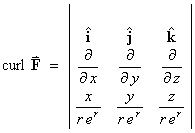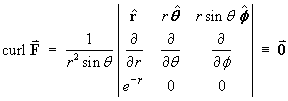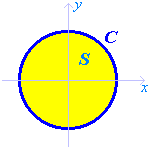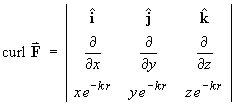ENGI 5432 Advanced Calculus
Faculty of Engineering and Applied Science2009 Winter
Problem Set 7 - Solutions
- Show that no potential function exists for the vector field
 .
.

It is not the case that the curl is zero everywhere in 3.
3.
Therefore no potential function exists for this vector field F
OR
Try to find a potential function:


where g(y, z) is an arbitrary function of integration.
 which is not a function of x
which is not a function of x
 which is
a function of x
which is
a function of x
This is a contradiction.
Therefore no potential function exists for the vector field F.
- For the vector field

- Show that a potential function
V(x, y, z) does exist.




 (everywhere in
(everywhere in  3), so a potential
function V (x, y, z) does exist.
3), so a potential
function V (x, y, z) does exist.
[or the fact that a potential function can be found in part (b) below
establishes the answer to this part of the question.] - Find the potential function
V(x, y, z)
that is defined in such a way that the potential is zero
at the origin.

where f (y, z) is an arbitrary function of y and z.


Þ V = exyz + x2 + yz + g (z)


Þ V = exyz + x2 + yz + C
But V = 0 at (0, 0, 0) Þ 0 = 1 + 0 + 0 + C Þ C = -1
Therefore the potential function is
- Show that a potential function
V(x, y, z) does exist.
- For the vector field

is the distance of the point (x, y, z) from the origin):- Show that a potential function
V(x, y, z) does exist.
First note that

and, by symmetry,

Thus, for any differentiable function f(r)
 , etc.
, etc.

The x component of curl F is

and, by symmetry, the other components of curl F are also zero.
 (everywhere in
(everywhere in  3), so a potential
function V (x, y, z) does exist.
3), so a potential
function V (x, y, z) does exist.
OR
F is spherically symmetric. Switch to spherical polar coordinates


 (everywhere in
(everywhere in  3), so a potential
function V (x, y, z) does exist.
3), so a potential
function V (x, y, z) does exist.
[or the fact that a potential function can be found in part (b) below
establishes the answer to this part of the question.] - Find the potential function
V(x, y, z)
that is defined in such a way that the potential is zero
at infinity.
[Hint: work in spherical polar coordinates.]




Therefore the potential function is
- Hence evaluate the line integral

where C is the arc of { 700x2 + 225z2 = 144, y = -0.6 } between the points(0.3, -0.6, 0.6) and(0, -0.6, 0.8).
[You may leave your answer in terms of powers of e.]
The existence of the potential function Þ the line integral is path-independent.

At (0, -0.6, 0.8) r2 = 02 + 0.62 + 0.82 = 1
At (0.3, -0.6, 0.6) r2 = 0.32 + 0.62 + 0.62 = 0.92
Therefore the value of the line integral is
In principle the line integral can be evaluated directly, using the parameterization

but the evaluation of the integral is not easy! - Find the absolute maximum and absolute minimum values of the
potential function V.
V = -e -r has an absolute minimum of -1 at the origin
and an absolute maximum of 0 at infinity. - What type of curve is
{ 700x2 + 225z2 = 144,
y = -0.6 }?
It is an ellipse, centre (0, -0.6, 0), in the plane y = -0.6
- Show that a potential function
V(x, y, z) does exist.
- Parabolic cylindrical coordinates are defined by

u = uo andv = vo are therefore vertical parabolic cylinders intersecting each other at right angles, while the third set of coordinate surfaces are the familiar horizontal planesz = zo. - Determine the scale factors hu ,
hv , hz .






- Hence find the expression for the volume element
dV = dx dy dz in terms of the differentials
du dv dz.
[The term multiplying du dv dz is the Jacobian
dV = dx dy dz = hu hvhzdu dv dz. Therefore,

- Determine the gradient vector Ñf
(u, v, z).

Therefore,

(except on the z-axis) - Determine the Laplacian
Ñ2f
(u, v, z).


Therefore,

(except on the z-axis)
- Determine the scale factors hu ,
hv , hz .
- Calculate the circulation of
 counterclockwise around the unit circle in the xy-plane.
[Hint: Use Stokes’ theorem, letting the surface
S be any smooth surface that has C
as its boundary.]
counterclockwise around the unit circle in the xy-plane.
[Hint: Use Stokes’ theorem, letting the surface
S be any smooth surface that has C
as its boundary.]
 Choose S to be the interior of
the unit circle C
in the x-y plane.
Choose S to be the interior of
the unit circle C
in the x-y plane.The domain of F is all
 3,
so Stokes’ theorem is valid.
3,
so Stokes’ theorem is valid.

And on S, z = 0 Þ

Surface net method
The circular disk suggests the parameters ( r, q ) such that


Choose the “outward” normal to be pointing up out of the x-y plane in the direction of increasing z. Then



![[surface integral of curl F]](p7/image127.gif)

![[ -(cos(2 theta))/8 + (theta)/2 ] (evaluated at 2pi, 0)
= (-1/8 + pi) - (-1/8 + 0)](p7/image133.gif)
Therefore,

OR
Projection methodIn this case, the projection is trivial, as the entire surface is already on the x-y plane.
Formally,


But S is the interior of a circle, not a rectangle, so use plane polar coordinates.
dA = r dr dq Þ dS = k r dr dq and



![[surface integral of curl F]](p7/image127.gif)

![[ -(cos(2 theta))/8 + (theta)/2 ] (evaluated at 2pi, 0)
= (-1/8 + pi) - (-1/8 + 0)](p7/image133.gif)
Therefore,

OR [ignoring the hint]
The line integral can be evaluated directly:
On C an obvious parameterization is
x = c, y = s, z = 0, where c = cos q and s = sin q




![[c^2 / 2 + theta/2 - sin 2theta / 4 - c^4 / 4]_0^2pi](p7/image160.gif)

Therefore,

- Consider the purely radial vector field
 where
where
 is the unit radial vector in the
spherical polar coordinate system and f (r)
is any function of r that is differentiable
everywhere in
is the unit radial vector in the
spherical polar coordinate system and f (r)
is any function of r that is differentiable
everywhere in
 (except possibly at the origin).
(except possibly at the origin).
- Find an expression, in terms of r,
f (r) and f ' (r), for
the divergence of F.



- Find an expression, in terms of r,
f (r) and f ' (r), for
the curl of F.
![curl F = [determinant]](p7/image171.gif)


Therefore,

- Is F a conservative vector field?
curl F
 0
Þ YES,
F is a conservative vector field
0
Þ YES,
F is a conservative vector field - Of particular interest is the central force law

 (except possibly at the origin) if and only if
(except possibly at the origin) if and only if
n = 2 .
[Two of the four fundamental forces of nature, electromagnetism and gravity, both obey this inverse square law.]


Þ div F 0 iff
n = 2.
0 iff
n = 2. [Note: n = 2 recovers the familiar inverse square law,

for which div F 0 and curl F
0 and curl F
 0 for all r
> 0.]
0 for all r
> 0.]
- Find an expression, in terms of r,
f (r) and f ' (r), for
the divergence of F.
- An extended source of electric charge has a charge density

- Find the total charge Q due to this extended
object.
The charge is non-zero on and within a sphere of radius 2, centre the origin.
Therefore work in spherical polar coordinates.



= (2p - 0) (1 + 1) (-38e-2 + 6)

- Find the total flux due to the extended charge through the simple
closed surface S defined by
(x-3)2 + (y-4)2 + z2 = 1.
S is a sphere, centre (3, 4, 0), radius 1.
The centre of S is 5 units away from the origin O
All parts of S are therefore at least 4 units away from O
The charge extends no more than 2 units away from O.
Therefore the surface S encloses no charge at all.
![[graph of sphere, completely outside the charge]](p7/image196.png)
From Poisson’s equation div E 0 everywhere inside S
0 everywhere inside S
Using Gauss’ divergence theorem,

Therefore the total flux through S is zero.
- Find the total charge Q due to this extended
object.
For the vector field F = e- k r r, where
 and k is a positive constant,
and k is a positive constant,- find the divergence of F .
Note:

By symmetry,

and by symmetry


and the other two partial derivatives follow by symmetry



- find the curl of F .

The x component of curl F is
The y component of curl F is
The z component of curl F is
Therefore
and F is IRROTATIONAL
[Note: All purely radial vector fields are irrotational.] - find where div F = 0 and classify this
surface.


sphere, radius 3/k, centre at the origin. - find where the magnitude F of the
vector field F attains its maximum value.
F > 0 and is differentiable for all r > 0
F (0) = 0 and F decreases asymptotically to zero as
A sole extremum in r > 0 must therefore be the absolute maximum.


Þ Fmax occurs on thesphere, radius 1/k, centre at the origin. - show that
 is a potential function for the vector field F.
is a potential function for the vector field F.

 a potential function V exists such that
a potential function V exists such that

 (chain rule)
(chain rule)

By symmetry,

Therefore, V is a potential function for F. - find the work done to move a particle from the origin to a place
where div F = 0.


- find the divergence of F .